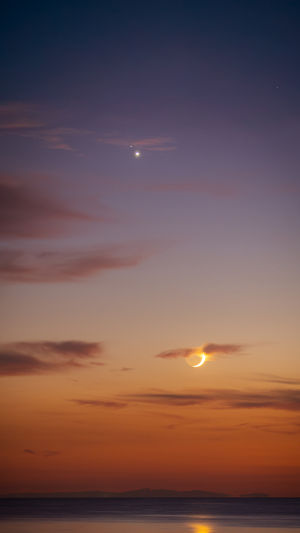If you've been watching the western sky after sunset lately, you might have seen a bright, golden point of light standing out among the dimming sky. That dazzling "evening jewel" is Venus.
It often shines like a tiny sunset captured in the sky, and its steady brilliance has a fascinating, entirely scientific explanation.
Tonight, we're going to explore why Venus glows so intensely and why it can remind us of the warm colors of a setting sun, even from millions of kilometers away.
<h3>The Reflective Power of Venus</h3>
The most important reason Venus shines so brightly is its atmosphere. Venus has a thick layer of clouds, full of sulfuric acid droplets, that acts like a mirror in space. This makes Venus's albedo—its reflective ability—an astonishing 0.76. That means Venus reflects 76% of the sunlight it receives, compared with 31% for Earth and only 12% for the Moon.
These clouds scatter sunlight in all directions, creating a steady and intense glow. Essentially, Venus's thick clouds make it appear as a shining golden orb, much like the diffused warm light we see during sunset.
<h3>Close Proximity to Earth</h3>
Venus's brightness isn't just about reflection. Its closeness to Earth makes a huge difference. At its nearest, Venus is only about 40.5 million kilometers away. That's much closer than most other planets, so the light we see is stronger and more concentrated. This proximity also means Venus appears larger in our sky, making its glow more noticeable. In other words, Venus doesn't just shine well—it shines right in our line of sight, almost like it's trying to show off its sunset glow.
<h3>Orbital Position Matters</h3>
Venus's orbit also plays a crucial role in how we see it. Venus moves around the Sun faster than Earth, completing its orbit in 224.7 days, while Earth takes 365 days. These differences in speed and position create patterns in the sky. When Venus is at its greatest elongation—either east or west from the Sun—it forms the largest angle in our sky.
This means we can see more of its illuminated side, producing a bright, noticeable disk. Evening appearances after sunset are called the Evening Star, while morning appearances before sunrise are called the Morning Star. During these times, Venus shines like a golden jewel, similar to a miniature sunset in the sky.
<h3>The Role of Phases</h3>
Like the Moon, Venus goes through phases. Sometimes it's nearly full, and other times it's a thin crescent. Interestingly, Venus often appears brightest when it is closer to Earth as a crescent. Although less of the planet is illuminated, the shorter distance makes the reflected sunlight even more intense. This combination of closeness and phase makes Venus look dazzling—almost like the sun itself is trapped in a small, golden globe in our evening sky.
<h3>Atmospheric Effects on Earth</h3>
Even though Venus is brilliant on its own, our atmosphere enhances its sunset-like appearance. Around dusk, our atmosphere scatters blue light, leaving warm oranges, reds, and yellows. When we see Venus through these colored skies, it seems to shimmer with a soft golden glow, like it's part of the sunset. In reality, Venus itself isn't changing color—but the combination of its reflection and our atmosphere creates a magical effect.
<h3>Transits and Rare Highlights</h3>
Venus also has moments when it performs rare cosmic "tricks." During a transit, Venus passes directly between Earth and the Sun, appearing as a small black dot slowly moving across the Sun's surface. While transits are extremely rare, they highlight how Venus's position can create unique visual experiences. Even in everyday viewing, knowing about its movement and phases adds depth to what we see in the evening sky.
<h3>Venus as a Celestial Reminder</h3>
Venus's bright, sunset-like glow reminds us that even a single planet in the sky carries complex science. Its thick clouds, reflective atmosphere, orbit, and proximity all combine to give us one of the most dazzling objects visible to the unaided eye. It's a constant reminder that our night sky isn't static; it's dynamic, beautiful, and full of subtle effects waiting to be noticed.
<h3>Keep Watching!</h3>
So next time we catch Venus glowing like a tiny sunset, we can appreciate it as more than just a bright dot. It's a moving, shining world, reflecting sunlight, showing phases, and interacting with our atmosphere to create a magical scene. Lykkers, have you ever noticed how the color of Venus changes slightly with the sky around it? Observing it can be a simple, daily way to connect with the wonders of our solar system. Let's keep looking up and enjoy Venus's golden glow together!





